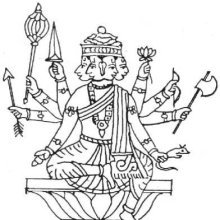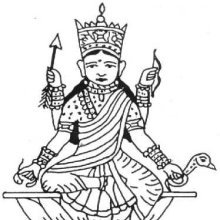Vairoti, Vairoṭi, Vairoṭī: 1 definition
Introduction:
Vairoti means something in Jainism, Prakrit. If you want to know the exact meaning, history, etymology or English translation of this term then check out the descriptions on this page. Add your comment or reference to a book if you want to contribute to this summary article.
Images (photo gallery)
In Jainism
General definition (in Jainism)
Source: archive.org: The Jaina Iconography1) Vairoṭi (वैरोटि) (or Vijayā, Viditā) is the name of the Yakṣiṇī accompanying Vimalanātha: the thirteenth of twenty-four Tīrthaṃkaras or Jinas, commonly depicted in Jaina iconography.—[...] The Śvetāmbaras know this Yakṣiṇī as Viditā or Vijayā. She is described in their books as seated on a lotus and as having four hands with an arrow, noose, bow and snake. The Digambara Vairoṭi appears in representations as riding on a snake (Goṇasa) and bearing in her hands two snakes, bow and arrow. Vairoṭi figures also like others as a Vidyādevī. The other name of Viditā means “learned one”. This would suggest the central idea of Goddess of learning. In other respects, Viditā or Vijayā with her colour of yellow, symbols of bow, arrow, snake and lotus or the vehicle or Goṇasa seems to be a clear derivative of a form of Durgā. The name of Vijayā, it is worth observing, retains the original name of her archetype.
2) Vairoṭi (वैरोटि) (or Aparājitā, Dharaṇapriyā) is also mentioned as the Yakṣa accompanying Mallinātha: the nineteenth of twenty-four Tīrthaṃkaras or Jinas, commonly depicted in Jaina iconography.—[...] The Yakṣiṇī, in her Śvetāmbara appearance, is to be represented as seated on a lotus, and carrying in her hands Varada, rosary, citrus, and Śakti. Aparājitā, the Digambara counterpart, is represented by their texts as a Goddess riding a lion and bearing hands, equipped with a citrus, sword, shield and Vara-mudrā. The citrus symbol, in both the forms, makes the goddess typically a Yakṣiṇī.
The name Vairoṭi occurs in connection with the Vidyādevīs and as a presiding deity over learning, she has a lion as her vehicle. We find, however, the lion symbol in the case of Aparājitā, the Digambara form of the Yakṣiṇī. We had occasion of describing Vairoṭi as the Digambara counterpart of Vijayā. There seems to be an exchange in the pair of combinations. Vijayā and Aparājitā seem to be the same in meaning; the original idea of both must have been derived from that of Durgā, who bears the same names in Brahmanism.
3) Vairoṭī (वैरोटी) or Vairoṭyā also refers to one of the sixteen Vidyādevīs (goddesses of learning).—The Śvetāmbara text represents the goddess [Vairoṭī] as riding on a snake and carrying in her hands a sword, snake, shield and snake. The Digambaras’ Vidyādevī rides a lion and has a snake symbol. The Yakṣiṇī of the identical name occurs in the Digambara iconography and belongs to Vimalanātha. Her vehicle and symbol in both the instances consist of snakes. That there exists a sure cognateness between the conception of the Vidyādevī and the Yakṣiṇī is clearly indicated by a Digambara text whichin an invocation calls the latter a Vidyādevī.

Jainism is an Indian religion of Dharma whose doctrine revolves around harmlessness (ahimsa) towards every living being. The two major branches (Digambara and Svetambara) of Jainism stimulate self-control (or, shramana, ‘self-reliance’) and spiritual development through a path of peace for the soul to progess to the ultimate goal.
See also (Relevant definitions)
Full-text: Vairotya, Vidita, Aparajita, Svayambhu, Shanmukha, Dharanapriya, Jambu, Vidyadevi, Vijaya, Caturmukha, Vimalanatha.
Relevant text
Search found 4 books and stories containing Vairoti, Vairoṭi, Vairoṭī; (plurals include: Vairotis, Vairoṭis, Vairoṭīs). You can also click to the full overview containing English textual excerpts. Below are direct links for the most relevant articles:
Jain Remains of Ancient Bengal (by Shubha Majumder)
Images of Tīrthaṅkara Vimalanātha < [Chapter 6 - Iconographic Study of Jaina Sculptural Remains]
The twenty-four Tīrthaṅkaras and their Yakṣas and Yakṣiṇīs < [Chapter 6 - Iconographic Study of Jaina Sculptural Remains]
Jainism in Odisha (Orissa) (by Ashis Ranjan Sahoo)
Iconography of Jain Gods and Goddess < [Chapter 6]
Iconography of Sasanadevis < [Chapter 6]
A study of the philosophy of Jainism (by Deepa Baruah)
Chapter I.c - The lives of the Tīrthaṅkaras < [Chapter I - Introduction]
Saraswati < [Aug - Sept 1939]

